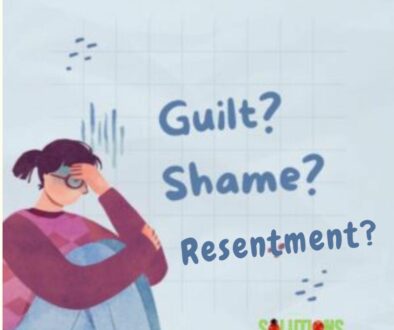From Blowing a Fuse to Emotional Regulation

Most of us have done it. We have walked out on a loved one, slammed a door, said something we regretted or burst into rage or tears. I have been there screaming, “I will go crazy if you don’t do that!” I needed to learn emotional regulation skills. By the way, I did!
We tend to worry too much, resent too much, complain too much, and feel angry too much. Toddlers are known for their temper tantrums and teen-agers are known for their sullenness or screeching “I hate you!” Regrettably, some times, some adults are also known for not managing their emotions.
Researchers at The Heart Math Institute, Dr Bruce Perry, who works with traumatized children, and the late Dr Al Siebert, the resiliency researcher, have developed methods to help us regulate our emotions and, consequently, our behaviors.
What is Emotional Regulation?
It is a way to adapt our thoughts and help calm our feelings to circumvent our out-of-control reactions. Let me make it clear that we are not describing denying, stifling or bottling up emotions. Feelings actually need to be acknowledged before they can be contained and regulated.
Think of Emotional Regulation as self-soothing. Attentive parents bond to their infant children by holding, rocking, and meeting their needs. Later, attentive parents acknowledge what their children feel and help them name those feelings. These care giving behaviors set the grounding for our adult Emotional Regulation. Without this emotional foundation we are susceptible to emotional outbursts.
Yet, as independent adults we can discover and practice healthy self-soothing patterns. Psychology has researched and developed effective means for us to do that. To begin here is what happens when we become dis-regulated.
Five Steps to Blowing a Fuse
- A situation or event triggers the lower, primitive part of the brain (older, survival or reptilian brain). Examples: You are called a rude name, are told you have lost your job or a relationship ends.
- The primitive brain makes associations to past trauma (often from the first 4 years of life). Examples: being left alone in an unsafe situation, shamed or verbally, physically or sexually abused.
- A flight, fright or freeze effect is activated. Heart rate increases, nerve ends tense, breathing becomes shallow, and senses become hyper vigilante.
- The frontal or cortical area of the brain (thinking brain) shuts down. You can not think!
- A reaction, versus calm and collected response, occurs. It feels as if you are exploding with words, gestures and/or physical action.
Dr Perry has said, “The only way to move from these super-high anxiety states, to calmer more cognitive states, is through rhythm. . . walking, running, singing, repetitive meditative breathing.” Here are five steps to help us to regain emotional regulation.
Five Steps to Emotional Regulation
- A situation or event triggers the lower, primitive or older part of the brain (survival or reptilian brain).
- Your frontal (thinking brain) is activated to remind you that you have a choice.
- You choose to self-detach from your emotional state. You imagine being a fly on the wall as if watching yourself in a movie. You become no longer a hostage to your feelings.
- You utilize or breathing or other self-soothing rhythms to bring you to calm.
- You choose what to say or do next.
Five Ways to Strengthen Your Emotional Regulation
- Develop a practice of breathing, meditation, yoga or dancing that you can rely upon. At the same time, develop a sense of a witness or high self who watches with detachment. Ah-so, all is well.
- Practice self-compassion for those times you do blow a fuse.
- Learn to identity your feeling states and become more comfortable with the anxiety producing emotions.
- Have strategies to engage in difficult conversations.
- Deepen your sense of gratitude for moments of love, joy and disconnectedness.
Use the below 7 steps for small disturbances to help build your emotional regulation muscle.
Practice 7 Steps to Calm
- Name your distress. Learn to recognize when your hands are sweaty, your heart pounding, and thoughts spinning.
- Watch a breath go in your nostrils, into your heart, through your lungs and fill your belly.
- Watch that same breath go out and imagine it flowing out and down to your toes. Do that again, again, and again.
- Think of a pleasant time—a time in someone’s arms, watching a sun-set or laughing with a child.
- Imagine yourself stepping back from the cause of your distress. You could imagine yourself sitting on the moon and noticing. Name your distress in personal terms—insecurity, fear, excluded. “Is there a better way for me to manage this present situation?”
- Continue to notice and to breathe in and out of your heart. Gently ask yourself, “How can I take care of myself and how might I better manage this situation?”
- Use your heart and mind to either accept the situation or take your best action.
How do you regulate your emotions? Or would you like to know more about emotional regulation and/or anger management? Leave a comment below and I will be sure to respond.
Please check out these related posts:
- 7 Concepts to Help Get a Grip on Your Anger
- How To Be A More Resilient Adult: Explore Your Childhood Wounds!
![]()





April 21, 2022 @ 12:53 pm
This is a very insightful and informative comment. Thank you to the author for sharing this information.
April 27, 2022 @ 2:48 pm
Thank you for your acknowledgment. If you struggle with the hot-fire energy of anger to consider using an ager log as described in the post Use an Anger Log to Get A Grip at https://www.solutionsforresilience.com/anger-log/
December 5, 2018 @ 11:21 am
Nilson Peixoto is, hands-down, one of the best Social Workers at The Ontario Correctional Institute in Brampton, Ontario. He deserves a tremendous amount of respect for his direct approach to treatment. Some individuals are initially put-off by Mr. Peixoto’s assertive personality and become insecure in the early stages of treatment. However, in the long-run, you will find that he is a very helpful, patient, and compassionate counselor. He utilizes the principles of ‘resilience’ in much of his teaching. I believe you are one of his resources for professional insights.
December 5, 2018 @ 10:27 pm
Thank you for your comments William, or do you like to be called ‘Bill’? I do not know Nilson Peixoto but I welcome any remarks about those who are doing ‘good work’ to help heal those in unfortunate circumstances. Bravo Mr. Peixoto!
December 19, 2017 @ 2:01 am
Its a shame that Nilson Peixoto is a narcissistic egomaniac who pretends to do good but in reality takes great pleasure in bullying people that have zero ability to stand up for themselves. What’s worse is that he will use your fantastic article as a tool to promote his flawed process of “treatment”.
January 22, 2018 @ 1:58 pm
My apology William, in not seeing your comment until now. WOW! I neglected you for over a month. Not good, especially after your lovely acknowledgement of ‘fantastic article’. Call me ignorant, but I do not know what ‘Nilson Peixoto’ you are referring. Please inform us. OK? With appreciation, Patricia
June 23, 2015 @ 11:44 am
Terrific! Everyone should record this list and practice it. Best advice: “imagine being a fly on the wall as if watching yourself in a movie.” thanks Patricia!
June 23, 2015 @ 1:29 pm
Thank you for the comment, Hugh. There are a number of strategies to distance and calm ourselves from overwhelming, inappropriate and triggered emotions. But regardless of using ‘being a fly on the wall’ or other self-regulating, resilience building tools, it takes practice, as you well know, to build in the new habit. Note to other readers: Hugh is the author of Give Me a Break: The art of making time work for you. So he knows about habit formation.
June 19, 2015 @ 7:06 am
Patricia, just read this article. Will be sharing it with some prisoners whom i am running a group for on pro-social values, problem solving and emotional regulation.
Loved this article’s simple and straightforward synopsis.
Thanks for your work on the resiliency front!
Have a good one,
Nilson – Brampton, ON.
June 21, 2015 @ 3:39 pm
Hi Nison,
I wanted to thank you for your comment. I have presented in Brampton and my cousin’s daughter, Heather is a teacher in a juvenile detention facility there. Thank you for doing challenging work.
Our daughter, Kelly spent time in and out of jail for 11 years as described in our book, Love Her As She Is: Lessons from a Daughter Stolen by Addictions. As it turns out she is affected with Fetal Alcohol Spectrum Disorder, which explains many of her out-of-control behaviours at the time.
Also your note reminds me of the years I used to ‘teach manners’ to Lifers. Quite the experience and Kelly would help me prepare for the workshops.
Again, thank you for the acknowledgement of my work and your commitment to helping those who need some extra support.
With appreciation, Patricia